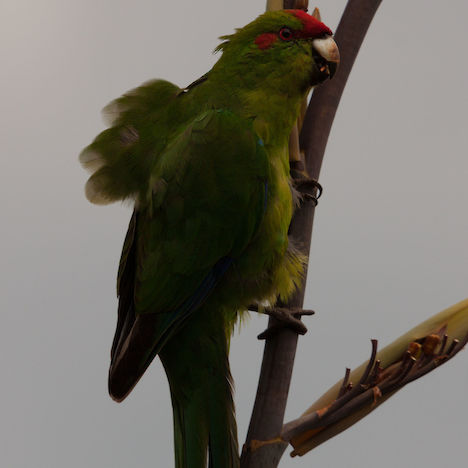Other names:
Red-headed parakeet, kākāriki, kakariki, kaka-wairiki, kawariki, porete, powhaitereThreat category:
At Risk: Relict?Regions:
Northland, Auckland, Waikato, Bay of Plenty, Gisborne, Hawkes Bay, Manawatu-Wanganui, Taranaki, Wellington, Nelson-Tasman, Marlborough, Westcoast, SouthlandDistribution:
Mostly on offshore islands, but occasional mainland sightings throughout much of mainland New Zealand
Description
- Red-crowned parakeets or kākāriki are small parrots with long tails, greenish-yellow plumage, a red crown, red forehead patch, and red band extending to behind the eye.
- The red-crowned parakeet call is a rapid, high-pitched chatter.
- The introduced eastern rosella is distinguished from red-crowned parakeets by its bright red head and breast, yellow underside, and a variety of loud calls. Yellow-crowned parakeets (Not Threatened) are differentiated from red-crowned parakeets by being smaller, having a yellow crown, and the red band stopping at the eye. Orange-crowned parakeets (Nationally Critical) are distinguished from red-crowned parakeets by having an orange band (only 100-200 birds are known in the wild from beech forests of upland valleys within Arthur’s Pass National Park and Lake Sumner Forest Park in Canterbury).
Interesting Facts
- Red-crowned parakeets, kea and kaka are omnivorous, taking berries, seeds, nectar and invertebrates
- Red-crowned parakeets typically nest in tree holes, particularly in old trees.
- Eight subspecies of red-crowned parakeets are known, though two are extinct (Lord Howe and Macquarie Island subspecies). Four are found in New Zealand.
- The species is occasionally observed in Southland; probably individuals dispersing from Stewart Island. Other South Island sightings are very rare. The species has been reintroduced to the mainland within the Zealandia predator-free sanctuary, and is occasionally observed around the region. The birds are also very rare in the remainder of the North Island, mostly seen in the Auckland/Northland region, and in central North Island. The species is common on offshore islands that are free of introduced terrestrial predators.
Association with Plantations
- Red-crowned parakeets may visit plantation forests to feed on invertebrates, indigenous fruits, and sometimes pollen cones and growing shoots of pines.
Threats
- Competition for food resources from possums, introduced wasps and possibly rats.
- Predation of eggs, young and adults by mustelids, cats, possums, and rats.
Management Options and Methods
- Undertake pest control if breeding populations are present in adjacent indigenous forest or remnants:
- Initially poison for possum and rats with secondary benefit of killing of mustelids and cats using 1080. Residual trap catch (RTC) monitoring needs to be less than 5% in order to allow kakariki to successfully breed.
- Follow-up trapping or poisoning may be needed (refer NZ pigeon).
- Undertake mustelid and cat control using Fenn traps for mustelids and kill-traps for cats (refer to Kiwi section).
- Wasp control – in parrot nesting areas consider searching for and destroying nests of common and German wasps using carbaryl or another similar toxin.
- Injured or dead birds:
- Place injured birds in a cardboard box (keep shaded) and deliver to a local vet, SPCA or DOC.
- Call DOC if bird has a band or bird is dead.
Monitoring Options
- Database of sightings, nest locations, protection methods, and breeding outcomes.
- Report findings to DOC.
Further Information and Support
- New Zealand Birds Online: red-crowned parakeet.
- Department of Conservation: New Zealand kākāriki / parakeets
- Heather and Robertson 2000. The Field Guide to the Birds of New Zealand. Viking. 440 pp.
- Pest management: DOC, Regional Councils.



